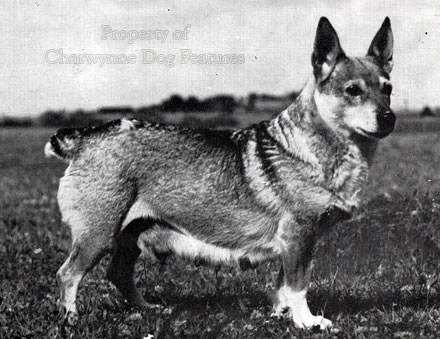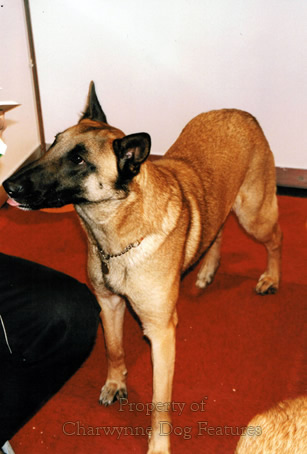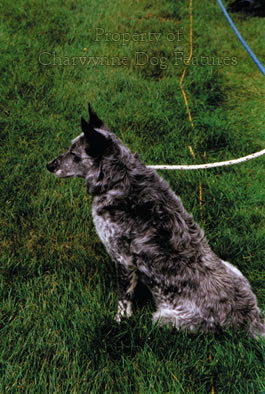861 BREEDING COMPANIONS
BREEDING COMPANIONS
by David Hancock
 “The potential stud dog must come of stock in which there is no known inherent tendency to any particular disease or constitutional weakness, quite apart from his merit on show points…The stud should also be a dog of excellent temperament, for the shy dog is the greatest detriment to any breed.”
“The potential stud dog must come of stock in which there is no known inherent tendency to any particular disease or constitutional weakness, quite apart from his merit on show points…The stud should also be a dog of excellent temperament, for the shy dog is the greatest detriment to any breed.”
From The Popular Collie by Margaret Osborne, Popular Dogs, 1960.
What do most dog-owners want in their pet dogs? Surely companionability, backed by health, vigour and longevity. But how little both serious innovation and enlightened enterprise feature in the breeding programmes of our pedigree dogs. Pure breeding is fine when strong healthy dogs result from it. But in so many of our pedigree breeds, there is a small gene pool and in all of them there is a closed gene pool. Our ancestors bred for results on legs not on paper and most of our revered pedigree breeds have a very mixed ancestry. Many scientists consider there is a proven case for producing healthy hybrids for the pet market and retaining pure breeds for show and breeding stock. In his most informative book If Dogs Could Talk - Exploring the Canine Mind, (Sutton, 2006), the Hungarian ethologist Vilmos Csanyi, makes a compelling case for it.
Knowledgeable breeders will of course point out that these so-called "healthy hybrids" could themselves produce any old stock and that there would be no assurance of type or quality beyond the F1 hybrid, or first generation. This I accept, but most dog-owners don't breed from their dogs; they would just be strong, healthy, long-lived pets costing little at the vets. Artisan hunters, with their "bobbery packs" of lurchers and terriers, don't care much which pure breeds their dogs come from but will not tolerate a dog that can't function or costs a fortune at the vets. Cross-breeding is no magic answer, there has to be quality behind both dam and sire as well as the skill in knowing how to blend the two.
Roy Robinson, in his Genetics for Dog Breeders of 1990, wrote: "If the outcross is wisely undertaken, it ought to be possible to preserve most of the better qualities of the strain, or at least not to lose too many. The first-cross progeny are often remarkably hardy and vigorous." But what is 'hybrid vigour'? Strictly speaking a hybrid is the result of a cross between different species, e.g. a sheep and a goat. But three types of crossing are possible: that between species, that between breeds and that between an animal pure for breed and one impure for that breed - a process known in farm animals as 'grading'. Livestock breeding always seems to be well ahead of dog breeding in utilising new scientific techniques; the BLUP (Best Linear Unbiased Prediction) system is available for farm livestock improvement in the UK but I believe has only been used in dog breeding in Germany. 
Using Outside Blood
In the world of the purebred dog, the use of greyhound blood could improve the hips of many breeds. The racing greyhound has the most perfect canine hips and could be used to improve the hips of other breeds so that the pet market doesn't have the agony of hip dysplasia manifesting itself in precious companion dogs. Such a cross could also be used with a Rottweiler to counter the predisposition of young Rottweilers to cranial cruciate ligament rupture. Other pedigree breeds could of course also benefit from such an outcross, but despite the clear benefits to dogs they claim to love, no pedigree dog breeder would consider such a step. If we want to breed healthier dogs for people who don't want to show a purebred dog, then F1 hybrids from crossing two different pedigree breeds are a definite option.
Bloodhound breeders revere the name of Brough, but ignore his advice to seek an outcross in every fifth generation. Setter breeders revere the name of Laverack, but never use his advice that "a change of colour is as good as a change of blood". If today's breeders of a pedigree setter breed won't themselves resort to this, then someone seeking a healthy setter as a country companion, would be well advised to buy an inter-bred one. Pet owners want healthy pets that live a long time and don't need costly veterinary attention. This would be the great benefit of hybrid vigour in dog breeding. The skill required by a show breeder to utilise outside blood is something else. Perhaps the best-ever Smooth Collie was Ch Eastwood Extra of a century ago; he was the result of Rough Collie-Smooth Collie mating. Could that happen today? Purity has replaced the pursuit of excellence. The KC now permits the planned use of Dual Sires, the dual matings to a bitch, by two sires not one, during one conceptual season. Far better genetic diversity could be obtained by mating two similar breeds together, but sadly pure-breeding is still worshipped despite the genetic limitations it inevitably brings with it. Pedigree dog breeding has long been over-rated.
Malcolm Willis, the eminent geneticist, in his 'Practical Genetics for Dog Breeders' of 1992, wrote: "...it is just as dangerous to overestimate pedigrees. Ancestors a long way back in the pedigree are not normally likely to be very influential even if those ancestors were outstanding specimens...a breeder who 'gets excited' about famous names in generation 20 would be deluding himself because most of them would be there in name only." But show-dog breeders are conformists, often buried in their personal interests. The great historian Friedrich Meinecke had a theory that man soon became blinded by his narrow 'specialisms', whatever the field of interest.
Recycling Old Genes
Most pedigree dog breeders practise inbreeding, often unthinkingly. Davies, in his valuable book, The Theory and Practice of Breeding for Type and its application to the breeding of dogs (undated but c.1930), wrote that: "Inbreeding creates nothing new. It merely ensures the perpetuation of qualities already present. Therefore it is as fatal a policy to inbreed indifferent specimens in the hope of improving the race as it is folly to cross a good race which shows no sign of deterioration...A common fallacy of the present day is to assume that inbreeding will to some extent do away with the need for selection...the exact opposite is the case...If eye and judgement be lacking no amount of theoretical knowledge can make the successful breeder." I have never come across a professional geneticist who was also an outstanding breeder of livestock of any kind. Outstanding parents don't always produce outstanding offspring; selection is the key skill.
Recycling genes within a breed is not always the best answer in attempti ng to improve the health and vigour of that breed. In their Genetics of the Dog - The Basis of Successful Breeding of 1966, Burns and Fraser make my point for me: "This suggestion of crossing with another breed will of course rather shock the pedigree purist. It was however used during the formative period of almost every breed and it is entirely unscientific to refuse to utilise the simplest method of attaining what is required. The important thing is to know exactly what is wanted from the crossing and to make only such matings as are necessary to attain that end."
ng to improve the health and vigour of that breed. In their Genetics of the Dog - The Basis of Successful Breeding of 1966, Burns and Fraser make my point for me: "This suggestion of crossing with another breed will of course rather shock the pedigree purist. It was however used during the formative period of almost every breed and it is entirely unscientific to refuse to utilise the simplest method of attaining what is required. The important thing is to know exactly what is wanted from the crossing and to make only such matings as are necessary to attain that end."
You can relate these words to the experience of the breeding manager to the Guide Dogs for the Blind Association. For several years the highest pass rate (86% in 1994) has been from Labrador cross Golden Retrievers. Against that evidence the forward plan of any commercial dog registry must embrace the registration of such crossbred dogs, they are the future. A club like the Kennel Club, created in different times, reluctant to change with the times and reliant on the sluggish attitudes generated by committees, is going to look increasingly primitive as the next millennium unfolds. As more scientific evidence is presented to us in each decade we must have the vision to make good use of it - or waste it.
Genetic ‘Junk’
I have already referred to the words, in Dogs in Canada magazine in May, 1994, of a professor in genetics, Dr RD Crawford who also pointed out some other valuable facts to breeders: "...the older the breed, the smaller will be the amount of genetic 'junk' that it contains; the younger the breed, the more defects will be present. For instance, very old breeds such as the Saluki, Pekingese and Basenji will only rarely express a severe genetic abnormality...the Standard Poodle has become the classic example of a dog breed that is highly inbred and as a result it now possesses a relatively 'clean' genotype." But those breeders inbreeding new breeds are going to have to demonstrate great skill if sound stock is to be produced. Most dog breeders breed on the phenotype (i.e. what the animal looks like), rather than the genotype (i.e. what genes the dog is carrying).
Without the breeding of one breed to another, we would not have most of the pedigree breeds of today. Why did skilled breeders like Dobermann and Korthals need to fuse the blood of different breeds? What was the purpose of Southern African hunters in producing the Rhodesian Ridgeback? The answer is functional excellence, supported by robustness and virility. Would our Welsh Corgi not benefit from an infusion of genes from look-alike breed the Swedish Vallhund? Could our Smooth Collie become more virile with added Malinois, or even Canaan Dog, blood? If our Bearded Collie has a small gene pool would the genes of the Polish Lowland Sheepdog or the Catalan Sheepdog help? If the Aussie Shepherd needs a bigger gene pool, we have plenty of native merle working collies to help the cause! For those screaming ‘What about precious breed type?’ I would point them towards the Corgi outcross used in the Boxer, by geneticist Bruce Cattanach, to install a naturally bob-tailed dog; after just 3 generations even breed specialists could not detect the outcross progeny from the pure version.
The Need for Hybrid Vigour
A decade ago, there was a series of articles either advocating cross-breeding or disparaging it, in one of the national dog papers. The advocacy argument was convincing; the disparaging response very disappointing and intellectually quite lightweight. This is a debate worth conducting and of more value to the domestic dog than any wordy show report. It is a rather sad fact that the words of the few scientists I have read who support and defend pure-breeding are themselves involved in the showing and breeding of purebred dogs. It is all too apparent where they are coming from and why their case is disappointingly tendentious. For a scientist not to have an open mind is worrying. The eminent British scientist Sir James Jeans wrote, a century ago: 'Science should leave off making pronouncements; the river of knowledge has too often turned back on itself'. The wish to improve dogs has to be heartfelt. 
Consumers generally have a higher expectation and an increased tendency to go to litigation in these times. Pet insurance is becoming very big business. Veterinary bills are rising steeply. A more sophisticated dog-owning public is just not going to tolerate sickly pets that die young even if they look roughly like their ancestors. If you add to this the strong moral conscience being increasingly applied in Western Europe nowadays then the intentional breeding from flawed stock is going to receive a more hostile response than in previous times. The general public is gradually getting to understand the emotional and financial penalties of short-lived, medically expensive, physically fragile dogs as pets. It is time for hybrid vigour to play a part in planned dog breeding. Who wouldn't welcome healthier dogs?
In his enlightening book, Vilmos Csanyi produces such phrases as: 'It is high time for breeders and their organisations to introduce, in their own self-interest, breeding criteria based on behaviour'...'Homozygous stocks pay a stiff price for genetic order. Whatever the species, its variability, resistance and performance are generally below that of heterozygous stocks'...'It is hardly possible to create a homozygous dog breed without damaging side effects.' He recommends the creation of uniform hybrids, by cross-breeding different existing breeds. But, as a scientist, he does point out that such hybrids should not be bred further. Their merit is not as breeding material, but as healthy stable companion dogs. This is after all, the main market for dogs.
Unverified Parentage
Having been a harsh critic of the KC at the end of the last century, I am heartened by some of the measures introduced by this body in the first part of the new century. They introduced in 2011 a pilot scheme that could enhance genetic diversity by allowing purebred unregistered dogs to be registered on the breed register on a case- by-case basis. I seem to recall a similar scheme 40 years ago. The KC statement read: “The move will if used enhance genetic diversity by widening breed gene pools and allowing new bloodlines to be introduced within breeds.” Allowance involves the owner certifying how the dog was obtained, and its source, then the application being supported by DNA profiling, health clearances, if relating to the breed claimed, then its phenotype verified as being representative of the breed claimed, by two championship level judges approved by the KC. One huge drawback could be inflexibility by breed judges, more interested in breed type than the breed’s future. I sometimes see working collies that simply take your breath away with their soundness and especially their movement. Their blood is important to the Border Collie’s future. Open-minded breeders are often the very best ones.
Importance of Disposition
In his enlightening book How To Breed Dogs (Orange Judd, New York, 1947) the highly experienced dog-breeder Leon Whitney wrote: "Now, as every breeder knows most dogs are bought on the basis of what cute puppies they are. The buyer hardly stops to ask, ‘Will it have a calm even disposition when it is grown?' Nor does the breeder usually stress disposition. Instead he brags about the wonderful champion show dogs in the pedigree - anything to sell the pup. Why can't breeders all realize that what makes dogs lastingly popular is first, disposition?" If the general public buy puppies without any regard to their likely temperament, is it at all surprising that children get bitten, breeds can get a bad name as a result and fewer sales in that breed ensue. Most 'returned' puppies are done so from behavioural defects. Were their parents well selected? 
Surely the very first question any responsible parent should ask when selecting a future family pet is: 'What is the temperament of the parents and previous litters from this mating?' Every breeder of purebred dogs needs sales to pet homes to sell litters; who is going to recommend breeders of dogs likely to have undesirable temperaments? The biggest single cause of each and every breed going into rescue is their temperament. What possible solace is there in saying later, in sorrow, that it was such a cute puppy! ' What comfort is it to be told that the dog that bit your child had ancestors that won Crufts? Even accredited breeders are not obliged to put temperament high on their list of desired qualities. Is this the best way to promote the breeding of companion animals? Is this the best way to promote the breed you love? Is this the best way to improve the man-dog relationship? Selectivity really does matter; selecting the breeder really does matter. Selecting the right genes is the key not just to breeding but successful ownership too.
“Breeders aspire to breed the perfect ‘specimen’ as laid down in the breed standard, but few Bernese are kept as rural farm-working dogs nowadays. The vast majority are in demand as family companions, and most live in urban, highly populated communities. Breeders must regard good temperament as the primary objective, and must ensure that biddable, predictable, and above all else, manageable temperaments abound. Bernese are indeed one of the most beautiful breeds, but without a good temperament that beauty is worthless – RELIABLE TEMPERAMENT IS EVERYTHING.”
Jude Simonds in an article in Our Dogs of November, 1998.